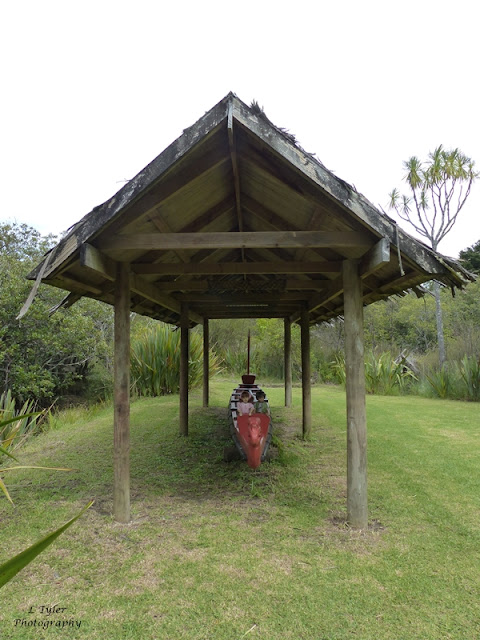Peggy Sue and I enjoyed looking round Rewa's Village while in Kerikeri.
Rewa's Village is a replica Maori fishing village of a pre-European era.
We pretended we were the occupants of the Chief's House
Welcoming any guests.
I of course MUST be the Chief!
We set off to explore more of the village
This is the Kauta, or Cooking Shelter where food was prepared and cooked.
Off to explore more....
Peggy Sue points out that this area is forbidden.
This is a carved Pou Rahui (Restriction Sign Post) that would have marked an area on which a Tapu (Restriction) had been placed.
We walk down to the river where you can see the Stone Store and Mission (Kemp) House
Behind us across the river you can see the Stone Store and Mission House and a yacht tied up at the wharf.
Peggy Sue asks me what is in there and I explain it is a storage pit in which Kumara (Sweet Potato) is stored.
We stand here for a while debating the merits of keeping food in an underground pit.
Peggy Sue wants to have a look inside.
I tells her there might be Weta inside so she decides not to go in! Probably a wise decision.
Outside the Food Storage Pit is where small kumara were offered to Kiora, a vegetarian rat which was also a supply of food.
We discover Waka Tiwai/Tete a fishing canoe and of course hop in it and pretend we are on the river.
The hull of the canoe was hollowed out from the trunk of a Kauri or Totara tree. Throughout the construction of a canoe rites and rituals were performed.
Peggy Sue found the site of an original Maori Hangi which is where river stones were heated above an open hole and once the wood had burned down, food was placed on the hot stones. The food was then covered with leaves and buried for cooking.
I don't look especially impressed here....
Perhaps I was expecting something a little more obvious...
...but then reminded myself that it is an archaeological site after all.
To show what it would have looked like, here is a replica Hangi.
We continue round the village.
...and find two Ancient Waka, which were salvaged locally from the swamps.
Again we of course climb in.
Beside the ancient Waka are a 'punga' or anchor fashioned from a rock to take a rope which was tied to the waka.
The Bark Whare (House) was constructed by driving two rows of stakes into the ground and laying branches between them. The roof is made from Totara bark.
We did have a peep in this one as it was a little more open than the underground storage pit.
Continuing on our walk.
We head up the hill.
Listening to the bird song as we go.
I spotted a Tui and Peggy Sue a fantail.
We can see the Whare Tohunga (High Priests Enclosure) and Pataka (Elevated Enclosure) ahead of us.
The front enclosure was Tohunga's and it was in need of repair and restoration!
This Whare was where the Tohunga lived. They were experts in various aspects of Maori life such as Waka building, carving (Whakairo), tattooing (Ta moko), building of Whares (houses) as well as medicinal and religious practices.
The Pataka or elevated enclosure was perhaps where they kept their stores high up off the ground.
We got quite a good view up here.
The village was really interesting but it was a bit 'tired' and need of work. The lady at the entrance said that they were in the process of working on it, so I do hope they do repair some of the damaged and run down exhibits.
Sitting on this post behind me is a magnificent view of the Stone Store and the Mission House (also known as Kemp House)
This is the oldest Stone building in New Zealand built between 1832 and 1836
The Mission House is the oldest surviving building in New Zealand having been built in 1822.













































Run down maybe, but the village still is a very interesting place - and you can use your imagination on how it might have looked when people lived there.
ReplyDeleteI love the stylish bermudas you're wearing, Henry. My boys are envious, but it's no bermudas weather in Germany yet.